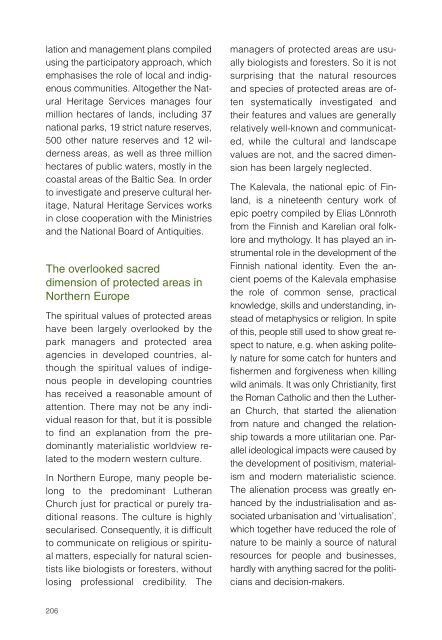The Diversity of Sacred Lands in Europe - IUCN
The Diversity of Sacred Lands in Europe - IUCN
The Diversity of Sacred Lands in Europe - IUCN
Create successful ePaper yourself
Turn your PDF publications into a flip-book with our unique Google optimized e-Paper software.
lation and management plans compiled<br />
us<strong>in</strong>g the participatory approach, which<br />
emphasises the role <strong>of</strong> local and <strong>in</strong>digenous<br />
communities. Altogether the Natural<br />
Heritage Services manages four<br />
million hectares <strong>of</strong> lands, <strong>in</strong>clud<strong>in</strong>g 37<br />
national parks, 19 strict nature reserves,<br />
500 other nature reserves and 12 wilderness<br />
areas, as well as three million<br />
hectares <strong>of</strong> public waters, mostly <strong>in</strong> the<br />
coastal areas <strong>of</strong> the Baltic Sea. In order<br />
to <strong>in</strong>vestigate and preserve cultural heritage,<br />
Natural Heritage Services works<br />
<strong>in</strong> close cooperation with the M<strong>in</strong>istries<br />
and the National Board <strong>of</strong> Antiquities.<br />
<strong>The</strong> overlooked sacred<br />
dimension <strong>of</strong> protected areas <strong>in</strong><br />
Northern <strong>Europe</strong><br />
<strong>The</strong> spiritual values <strong>of</strong> protected areas<br />
have been largely overlooked by the<br />
park managers and protected area<br />
agencies <strong>in</strong> developed countries, although<br />
the spiritual values <strong>of</strong> <strong>in</strong>digenous<br />
people <strong>in</strong> develop<strong>in</strong>g countries<br />
has received a reasonable amount <strong>of</strong><br />
attention. <strong>The</strong>re may not be any <strong>in</strong>dividual<br />
reason for that, but it is possible<br />
to f<strong>in</strong>d an explanation from the predom<strong>in</strong>antly<br />
materialistic worldview related<br />
to the modern western culture.<br />
In Northern <strong>Europe</strong>, many people belong<br />
to the predom<strong>in</strong>ant Lutheran<br />
Church just for practical or purely traditional<br />
reasons. <strong>The</strong> culture is highly<br />
secularised. Consequently, it is difficult<br />
to communicate on religious or spiritual<br />
matters, especially for natural scientists<br />
like biologists or foresters, without<br />
los<strong>in</strong>g pr<strong>of</strong>essional credibility. <strong>The</strong><br />
managers <strong>of</strong> protected areas are usually<br />
biologists and foresters. So it is not<br />
surpris<strong>in</strong>g that the natural resources<br />
and species <strong>of</strong> protected areas are <strong>of</strong>ten<br />
systematically <strong>in</strong>vestigated and<br />
their features and values are generally<br />
relatively well-known and communicated,<br />
while the cultural and landscape<br />
values are not, and the sacred dimension<br />
has been largely neglected.<br />
<strong>The</strong> Kalevala, the national epic <strong>of</strong> F<strong>in</strong>land,<br />
is a n<strong>in</strong>eteenth century work <strong>of</strong><br />
epic poetry compiled by Elias Lönnroth<br />
from the F<strong>in</strong>nish and Karelian oral folklore<br />
and mythology. It has played an <strong>in</strong>strumental<br />
role <strong>in</strong> the development <strong>of</strong> the<br />
F<strong>in</strong>nish national identity. Even the ancient<br />
poems <strong>of</strong> the Kalevala emphasise<br />
the role <strong>of</strong> common sense, practical<br />
knowledge, skills and understand<strong>in</strong>g, <strong>in</strong>stead<br />
<strong>of</strong> metaphysics or religion. In spite<br />
<strong>of</strong> this, people still used to show great respect<br />
to nature, e.g. when ask<strong>in</strong>g politely<br />
nature for some catch for hunters and<br />
fishermen and forgiveness when kill<strong>in</strong>g<br />
wild animals. It was only Christianity, first<br />
the Roman Catholic and then the Lutheran<br />
Church, that started the alienation<br />
from nature and changed the relationship<br />
towards a more utilitarian one. Parallel<br />
ideological impacts were caused by<br />
the development <strong>of</strong> positivism, materialism<br />
and modern materialistic science.<br />
<strong>The</strong> alienation process was greatly enhanced<br />
by the <strong>in</strong>dustrialisation and associated<br />
urbanisation and ‘virtualisation’,<br />
which together have reduced the role <strong>of</strong><br />
nature to be ma<strong>in</strong>ly a source <strong>of</strong> natural<br />
resources for people and bus<strong>in</strong>esses,<br />
hardly with anyth<strong>in</strong>g sacred for the politicians<br />
and decision-makers.<br />
206













